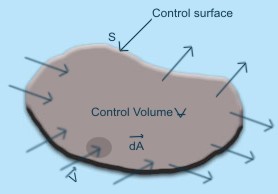|
Continuity
Equation: Integral Form
Let us consider a control
volume  bounded by the control surface S. The efflux
of mass across the control surface S is given by bounded by the control surface S. The efflux
of mass across the control surface S is given by
where
 is the velocity vector at an elemental area( which is treated
as a vector by considering its positive direction along the
normal drawn outward from the surface).
is the velocity vector at an elemental area( which is treated
as a vector by considering its positive direction along the
normal drawn outward from the surface).

Fig 10.2 A
Control Volume for the Derivation of Continuity Equation (integral
form)
The rate of mass accumulation
within the control volume becomes
where d is an elemental
volume, ρ is the density and is an elemental
volume, ρ is the density and  is the total volume bounded
by the control surface S. Hence, the continuity equation becomes
(according to the statement given by Eq. (9.1)) is the total volume bounded
by the control surface S. Hence, the continuity equation becomes
(according to the statement given by Eq. (9.1))
 |
(10.6) |
The second term of the Eq.
(10.6) can be converted into a volume integral by the use
of the Gauss divergence theorem
as
Since the volume  does not
change with time, the sequence of differentiation and integration
in the first term of Eq.(10.6) can be interchanged. does not
change with time, the sequence of differentiation and integration
in the first term of Eq.(10.6) can be interchanged.
Therefore Eq. (10.6) can be written as
 |
(10.7) |
Equation (10.7) is valid for any arbitrary
control volume irrespective of its shape and size. So we can
write
 |
(10.8) |
|